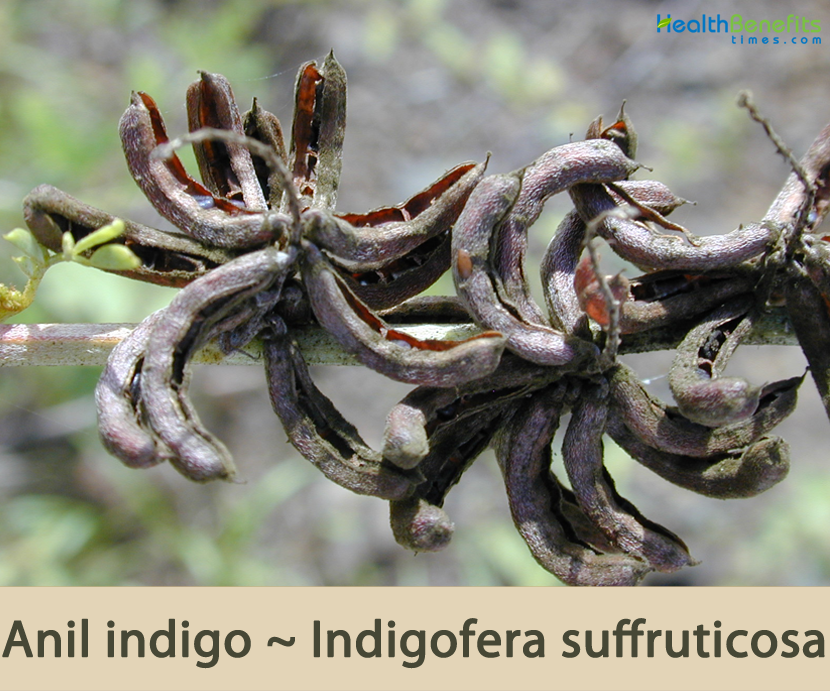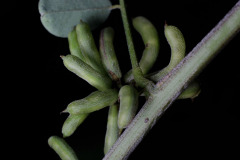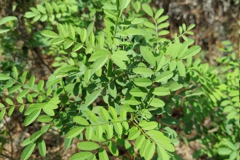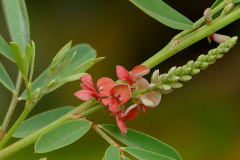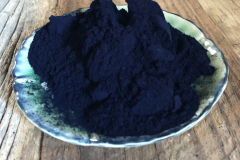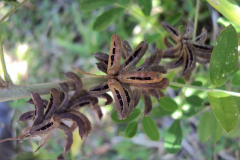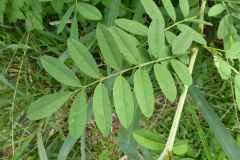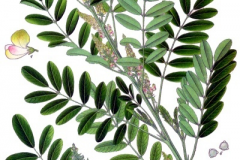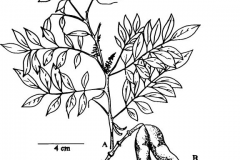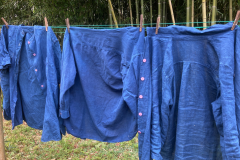Anil indigo has been known as ‘the king of dyes’ due to its fascinating deep blue color. It is commonly used as a source for indigo dye, and if mixed with Palygorskite clays, can produce Maya blue, a pigment used by the Mesoamerican civilizations. Medicinally, Anil indigo is applied to the bee and other insect’s stings to reduce pain and inflammation. Root decoction is used against stomach pain. The leaves are used for fever, and scrofula when combined with the bark of Philodendron chinense. Plant juice is used as a treatment for diarrhea.
Anil Indigo Facts
| Anil indigo Quick Facts | |
|---|---|
| Name: | Anil indigo |
| Scientific Name: | Indigofera suffruticosa |
| Origin | Subtropical and tropical Americas, including the southern United States, the Caribbean, Mexico, Central America, and South America as far south as northern Argentina |
| Shapes | 4-8-seeded pod, distinctly up-curved, sickle-shaped, about 1.5 cm long and 2 mm wide and hairy |
| Taste | Bitter |
| Health benefits | Support for stomach ache, fever, headaches, hemorrhage, convulsions, coughs, skin parasites, boils, urinary diseases, ulcers, syphilis, epilepsy and jaundice |
| Name | Anil indigo |
|---|---|
| Scientific Name | Indigofera suffruticosa |
| Native | Subtropical and tropical Americas, including the southern United States, the Caribbean, Mexico, Central America, and South America as far south as northern Argentina |
| Common Names | Anil, Anil indigo, Anil de pasto, Anil-de-Pasto, Bengal Indigo, Ceylon Indigo, Indigo Plant, Madras Indigo, West Indian Indigo, Wild Indigo, Indigobush, Guatemala Indigo, Markham Gungo, Indigo |
| Name in Other Languages | Brazil: Anil-dos-tintureiros, anileiro, caa-abi, caa-chica, guajan-timbe Cook Islands: Initiko Chamorro: Aniles Chinese: Ye qing shu (野青树), Yěmù lán (野木藍), Jia lan Dian, Jing Zi Dutch: Indigoboompje English: Anil, Anil Indigo, Anil de pasto, Guatemalan indigo, Small-leaved indigo, West Indian indigo, Wild indigo, Bengal Indigo, Ceylon Indigo, Indigo Plant, Madras Indigo Fijian: Vaivai French: Indigotier sauvage, Indigo Sauvage, Indigotier, Indigotier Sauvage, anil, indigo bâtard, indigo suffrutescent German: Westindischer Indigo, Mexikanischer Indigostrauch, westindischer Indigostrauch Hawaiian: Inikō, inikoa, kolū Hindi: Vilaiti nil, Nil, Vilayati Nil Indonesia: Taem-taem, tagom-tagom, tom-janti Irish: Ainil Italian: Endaco, indaco domestico, indaco franco Japanese: Nanbankomatsunagi (ナンバンコマツナギ) Kapampangan: Tayum Lithuanian: Krūmokšninė indigažolė Malay: Tarum Malaysia: Sakebak, tarom Malayalam: Amari (അമരി) Manx: Annyl Maori (Cook Islands): Initiko Persian: نیل وحشی Philippines: Sangifaria, tayum, tina-tinaan Polynesia: Aniles Portuguese: Anil, Anil de pasto, Anil-dos-tintureiros, Anileiro, Cáa-abi, Cáa-chica, Guajaná-timbé, Indigo, anileira Quechua: Tinaku Samoan: La‘au failafo Sinhalese: Nil-awari Spanish: Añil, Añil cimarrón, Azul azulejo, Azul de hoja, Jiquelite, Platanito de tinto, añil de pasto, curí, indigotero Swedish: Västindisk indigo Tamil: Shimaiyaviri, Nilam Thai: Khram yaiuai, khram-thuan (ครามเถื่อน) Tongan: Akauveli USA/Hawaii: Iniko, inikoa, kolu Vietnamese: Chàm bụi Wallisian: Akauveli |
| Plant Growth Habit | Stiffly erect, sparsely branched, perennial herb or woody shrub |
| Growing Climates | Roadsides, bush fallow, dry to wet fields, thickets, waste ground, hillsides, sandbars, cultivated ground, pastures, clearings, and other disturbed areas in the tropics, sub-tropics and warm temperate conditions |
| Soil | It occurs in a wide variety of soils including those of low fertility, and will grow in areas of full sunlight or partial shade. However, it will not tolerate full shade. It can occasionally be found in wetlands |
| Plant Size | Reaches 1 to 2 m in height and 1 to 2 cm in stem diameter |
| Stem | Gray-brown, pubescent, and more or less straight |
| Leaf | The light green leaves are pinnately compound, about 5 to 8 centimeters long with 9 to 17 leaflets on a 1.5 cm petiole. Leaflets are narrowly oblong, pubescent and are 1.5 to 2.5 cm long and about 9 mm wide. |
| Flowering season | March-May |
| Flower | Corolla is 4-5 mm long, salmon pink to red colored. Calyx is campanulate, 1 mm long, teeth triangular and 1 mm long. Standard petal is ovate to orbicular, 4 mm long and 3 mm wide, brown-hairy on the back, wings 3 mm long and 1 mm wide, glabrous |
| Fruit Shape & Size | 4-8-seeded pod, distinctly up-curved, sickle-shaped, about 1.5 cm long and 2 mm wide and hairy. Seeds are cubical, 1.5-2.0 mm long and 1.5 mm wide and shiny brown. |
| Seed | Seeds are cubical, 1.5-2.0 mm long and 1.5 mm wide and shiny brown |
| Taste | Bitter |
| Plant Parts Used | Leaves, seeds, roots |
| Propagation | By Seed |
| Season | June-October |
| Precautions |
|
Plant Description
Anil indigo is a stiffly erect, sparsely branched, perennial herb or woody shrub that normally grows about 1 to 2.5 m in height and 1 to 2 cm in stem diameter. It has a woody rootstock from which grows stems that are often woody and persist for more than a year but can also be herbaceous. The main stem is solid and is covered with a slightly rough dark brown bark. The younger branches are slightly pubescent and grooved. The plant is found growing in roadsides, bush fallow, dry to wet fields, thickets, waste ground, hillsides, sandbars, cultivated ground, pastures, clearings, and other disturbed areas in the tropics, sub-tropics and warm temperate conditions. It occurs in a wide variety of soils including those of low fertility, and will grow in areas of full sunlight or partial shade. However, it will not tolerate full shade. It can occasionally be found in wetlands.
Leaves
The light green leaves are pinnately compound, about 5 to 8 centimeters long with 9 to 17 leaflets on a 1.5 cm petiole. Leaflets are narrowly oblong, pubescent and are 1.5 to 2.5 cm long and about 9 mm wide. The smooth blade is glabrous on the upper side and covered with a slight pubescence applied on the lower side which gives it a more greyish appearance. There are narrowly triangular, about 6 to 8 mm long lanciolate stipules at the base of the leaves.
Flowers
Inflorescence occurs in an axillary raceme, 2-6 cm long. Bracts are narrowly triangular and pedicel up to 1 mm long. Corolla is 4-5 mm long, salmon pink to red colored. Calyx is campanulate, 1 mm long, teeth triangular and 1 mm long. Standard petal is ovate to orbicular, 4 mm long and 3 mm wide, brown-hairy on the back, wings 3 mm long and 1 mm wide, glabrous. 10 stamens are found, 1 free, 9 connate into a staminal tube 3-4 mm long. Ovary is hairy, style with capitate stigma. Stamens are 3-4 mm long. The flowers open progressively from the bottom to the top are grouped in lateral clusters. Flowering normally takes place in between March and May.
Fruit
Fertile flowers are followed by cylindrical pod, distinctly up-curved, sickle-shaped, about 1.5 cm long and 2 mm wide and hairy. Each pod consists of 5 to 6 black cylindrical seeds. Seeds are cubical, 1.5-2.0 mm long and 1.5 mm wide and shiny brown.
Traditional uses and benefits of Anil Indigo
- A decoction of the root is taken against stomach ache.
- Leaves are used for fever and scrofula (tuberculosis of the cervical lymph nodes) when combined with the bark of Philodendron chinense.
- Plant juice is used as a treatment for diarrhea.
- The plant finds some use in domestic medicine in Guatemala.
- Anil Indigo is often applied to the stings of bees and other insects to reduce pain and inflammation, although its efficacy is somewhat doubtful.
- Tincture of the roots and seeds in rum is used as a vermifuge.
- The leaves are resolutive and sudorific.
- An infusion of bruised leaves is used as a treatment for fever.
- The fresh leaves are used in a warm bath to act as a calmative.
- In Brazilian folk-medicine it is used for gastric disorders, infection and inflammation, acting as a gastro-protective agent, stimulating prostaglandin, mucus and HSP70.
- Small extract was effective in controlling head-lice in Cuba.
- Aqueous extracts of the leaves obtained by infusion, can be used in the treatment of skin diseases caused by dermatophytes and also against stomach-ache, fever and diarrhea in Malaysia.
- It is used for fever, headaches, hemorrhage, convulsions, coughs, skin parasites and boils.
- Bruised leaves are used as anodyne in warm baths.
- Decoction of leaves is used as sudorific.
- Aztecs used the seeds for urinary diseases and ulcers.
- Poultice of seeds applied to the head for fever.
- Whole plant is used as a remedy for syphilis.
- It is used for epilepsy.
- In Brazil, it is a reputed remedy for snake bites.
- In Mexico, leaves are used as cataplasm or decoction, applied to child’s forehead for fever, or other painful areas.
- Powdered seeds are used for ulcers.
- Tincture of roots and seeds are infused in rum used for destroying vermin on the human body.
- It is used against stomach and urinary problems, jaundice, and ulcers and also as an insecticide.
- Poultices and extracts of wild indigo leaves, alone or in combination with other ingredients, are used in herbal medicine to treat fever, headaches, hemorrhages, convulsions, acute cough, skin parasites, and boils.
Other Facts
- It has been known as ‘the king of dyes’ due to its fascinating deep blue color.
- It is grown as a cover crop and green manure in coffee, rubber and tea plantations.
- In South America it is one of the components of natural pastures developing after clearing rain forest.
- A good cover of the plant can increase the nitrogen content of the soil considerably.
- The plant is a major source of the blue dye indigo.
- Plants contain the glucoside indican, which transforms into indoxyl (indigo-white) and glucose by enzymatic hydrolysis.
- Anil indigo was formerly much planted in some parts of Guatemala, especially in the Oriente and along the Pacific foothills and plains, and some is grown even today, for dyeing native textiles.
- The indigo-colored coats and trousers forming the costumes of the men of certain highland towns are most distinctive.
- It is more important as a cover crop and green manure plant for coffee and tea in South and South East Asia, America and Africa.
- In Malaya and Java, it is used to be cultivated as green manure.
- Extract of leaves and stems used as ingredient in commercial preparations of skin conditioners.
- The powdered seeds and roots are used as an insecticide.
Prevention and Control
Due to the variable regulations around (de)registration of pesticides, your national list of registered pesticides or relevant authority should be consulted to determine which products are legally allowed for use in your country when considering chemical control. Pesticides should always be used in a lawful manner, consistent with the product’s label.
Physical/Mechanical Control
Seedlings are readily controlled by hoeing. Established plants have a deep root system but do not regenerates from below ground so may be controlled by suitable cultivation.
Biological Control
No known attempts have been made at biological control.
Chemical Control
In Vanuatu, a triclopyr/picloram mixture is recommended to be applied to young growth after slashing to 30-40 cm height and wetting of foliage is important. However, spraying is pointless where there is not an adequate under-storey of native or improved grass and legume, and if not, recommended pastures should be sown.
References:
https://www.itis.gov/servlet/SingleRpt/SingleRpt?search_topic=TSN&search_value=26749#null
http://www.hear.org/pier/species/indigofera_suffruticosa.htm
https://npgsweb.ars-grin.gov/gringlobal/taxon/taxonomydetail?id=20058
https://pfaf.org/user/Plant.aspx?LatinName=Indigofera+suffruticosa
https://www.cabi.org/isc/datasheet/28611
https://en.wikipedia.org/wiki/Indigofera_suffruticosa
https://gd.eppo.int/taxon/INDAN
http://www.stuartxchange.com/Tayum.html
http://tropical.theferns.info/viewtropical.php?id=Indigofera+suffruticosa
https://indiabiodiversity.org/species/show/230025
http://www.namethatplant.net/PDFs/Indigofera%20suffruticosa.pdf
https://plants.usda.gov/home/plantProfile?symbol=INSU


